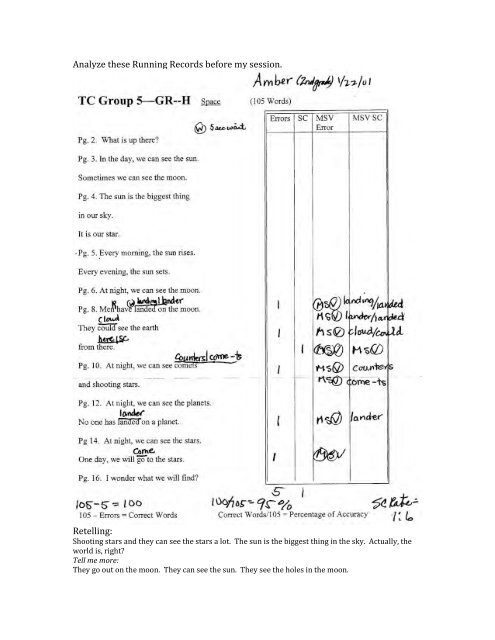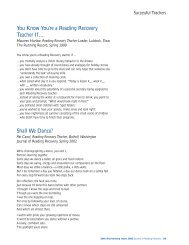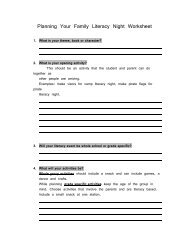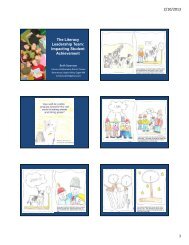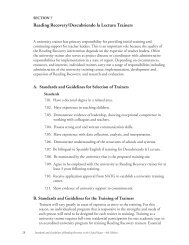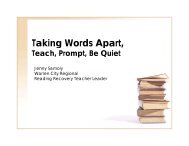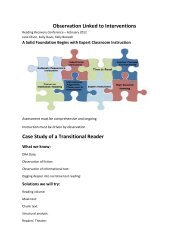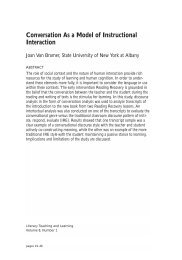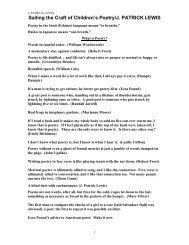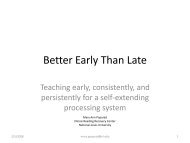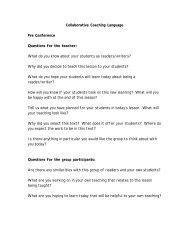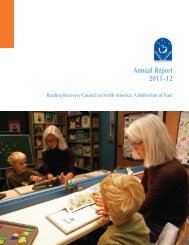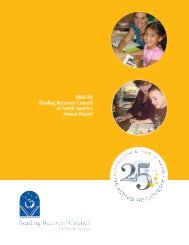Analyze these Running Records before my session. Retelling:
Analyze these Running Records before my session. Retelling:
Analyze these Running Records before my session. Retelling:
Create successful ePaper yourself
Turn your PDF publications into a flip-book with our unique Google optimized e-Paper software.
<strong>Analyze</strong> <strong>these</strong> <strong>Running</strong> <strong>Records</strong> <strong>before</strong> <strong>my</strong> <strong>session</strong>.<strong>Retelling</strong>:Shooting stars and they can see the stars a lot. The sun is the biggest thing in the sky. Actually, theworld is, right?Tell me more:They go out on the moon. They can see the sun. They see the holes in the moon.
<strong>Retelling</strong>:Somebody asked what was up in the sky. His mom told him what was in the sky then somebodylanded on Pluto. At the end they said, “I wonder what we will find?”
<strong>Retelling</strong>:It is about space. People went to Mars. The kids looked at the stars and wonderedwhat they would find when they went up there.Tell me more.They saw shooting stars and then they saw the moon.
<strong>Retelling</strong>: They talked about the Earth and other ones like Mars, Jupiter and Plutoand all those other ones. They flewn in a spaceship and they wondered, “What’s upthere?” They’re going to go up there to see it. They saw a shooting star. There werepeople on the moon. They said the sun is the brightest thing. In the day, the sunrises and when it is not in the daytime the sun can do a sunset.
Analysis:Looking across running records for this group, the following was noticed:1. Need work on blends and digraphs: cl, br, pl, th, sh (five children).2. Need work on inflectional endings: er, ed, ing, and s.3. High frequency word errors: that, a, the, what, there, here, came go, and am.4. Using known word chunks to unlock unknown words does not work. Switchto reading letter by part (chunk) from left to right across the word.5. Other miscues that may deal with vocabulary: comets, lined, landed,could/cloud, Pluto/planets, something/sometimes.6. <strong>Retelling</strong>s are weak across the group—the best is Ben.a. Confuse information.b. Setting and time of action is weak (e.g. Men on the moon is in the past, butthey state information as though it was in the present.).c. Some difficulty with verb tense (e.g. has/have)d. Some evidence of self-correcting when a word doesn’t make sense (e.g.learned/landed).e. But, some words are decoded using visual/graphophonics with noattention to meaning (e.g evering/evening).Classroom teacher’s observations and request:Enclosed please find the running records for the second grade groupyou’ll be working with on the 31 st . The second grade team was hopingyou could demonstrate different word problem-solving strategies withthis group. This is our lowest group currently in second grade. I haveattached several decoding strategies that we use here (e.g. using firstand last sounds, looking for little words in big words, sounding out).What other strategies can/should be used to help <strong>these</strong> children decodewords? I realize that their retelling scores are also low, but we wouldlike to concentrate on their decoding and self-correcting skills, this<strong>session</strong>.
Focus Skill Plannerfor Guided ReadingUse blends and digraphs at the beginningand ending of words.Attend to inflectional ending (s, ed, ing, ands. Note how they change meaning.Quick identification of high frequencywords, some with irregular spelling patters(i.e. what, there, here)Using the first consonant(s) plus the nextchunk along with meaning to read words.Notice how events in story communicatemeaning, setting, mood, tone, and otheraspects of meaning.©Joe Yukish, July 9, 1999This form is designed to help teachers provide focused instruction during guided reading. Analyzing running records,reflecting on teacher observations during instruction, and other assessment information, identifies focus skills/strategiesfor children in a guided reading group. These are listed in the horizontal columns. The names of children in the guidedreading group are listed vertical columns. The teacher records a (+) to identify focus skills individual children haveacquired. She records a (-) for those focus skills that are not yet in a child’s repertoire.In guided reading groups of 6 + 2 children, it is unlikely that every child will need to be taught the same focusskill or reading strategy. Therefore, multiple focus skills and strategic behaviors are listed on the Focus SkillPlanner..1. For some children presentation of any one of <strong>these</strong> specific skill or strategy during a guided readinglesson will be viewed as maintenance learning, or a time for review of something previously learned.Holdaway [1] says <strong>these</strong> children need opportunities for unsupervised practice and performance of anewly learned behavior. If too many of the focus skills are already mastered and completed by <strong>these</strong>children with little attention, the children need to be moved to another group where more of the focusskills and strategies being taught are at Holdaway’s guided participation level.2. For other children, hopefully a majority of the group, many of the focus skills will be just what theyneed. For them, the teacher will present <strong>these</strong> skills or strategies during guided reading in a way thatthey can be acquired. Holdaway [1] calls this “guided participation.” The teacher models/shows/tells<strong>these</strong> children how to use the skill/strategy. Cambourne [2]says she creates an expectation in <strong>these</strong>children that they can learn, scaffolding them into taking responsibility to use the skill/strategy3. For other children in the group, the teacher’s presentation of the skills/strategies to other children inguided reading group will be a model of an upcoming skill or strategy they will acquire—Holdaway’s[1] observation of demonstration and Cambourne’s [2] immersion/demonstration types of engagement.(Note: if most of (or all of) the focus skills listed horizontally fall in this category for any groupmembers, they should be moved into another group where more of the focus skills are at the guidedparticipation level for them.1. Holdaway, D. The structure of natural learning as a basis for literacy instruction. In The pursuit of literacy: Earlyreading and writing. M.R. Sarason, Editor. 1986, Kendall-Hunt: Dubuque, IA. p. 56-72.
2. Cambourne, B. The whole story: Natural learning and the acquisition of literacy in the classroom. 1988, Auckland,New Zealand: Scholastic.Focus Skill Plannerfor Guided Reading©Joe Yukish, July 9, 1999This form is designed to help teachers provide focused instruction during guided reading. Analyzing running records,reflecting on teacher observations during instruction, and other assessment information, identifies focus skills/strategiesfor children in a guided reading group. These are listed in the horizontal columns. The names of children in the guidedreading group are listed vertical columns. The teacher records a (+) to identify focus skills individual children haveacquired. She records a (-) for those focus skills that are not yet in a child’s repertoire.In guided reading groups of 6 + 2 children, it is unlikely that every child will need to be taught the same focusskill or reading strategy. Therefore, multiple focus skills and strategic behaviors are listed on the Focus SkillPlanner..4. For some children presentation of any one of <strong>these</strong> specific skill or strategy during a guided readinglesson will be viewed as maintenance learning, or a time for review of something previously learned.Holdaway [1] says <strong>these</strong> children need opportunities for unsupervised practice and performance of anewly learned behavior. If too many of the focus skills are already mastered and completed by <strong>these</strong>children with little attention, the children need to be moved to another group where more of the focusskills and strategies being taught are at Holdaway’s guided participation level.5. For other children, hopefully a majority of the group, many of the focus skills will be just what theyneed. For them, the teacher will present <strong>these</strong> skills or strategies during guided reading in a way thatthey can be acquired. Holdaway [1] calls this “guided participation.” The teacher models/shows/tells<strong>these</strong> children how to use the skill/strategy. Cambourne [2]says she creates an expectation in <strong>these</strong>children that they can learn, scaffolding them into taking responsibility to use the skill/strategy
6. For other children in the group, the teacher’s presentation of the skills/strategies to other children inguided reading group will be a model of an upcoming skill or strategy they will acquire—Holdaway’s[1] observation of demonstration and Cambourne’s [2] immersion/demonstration types of engagement.(Note: if most of (or all of) the focus skills listed horizontally fall in this category for any groupmembers, they should be moved into another group where more of the focus skills are at the guidedparticipation level for them.1. Holdaway, D. The structure of natural learning as a basis for literacy instruction. In The pursuit of literacy: Earlyreading and writing. M.R. Sarason, Editor. 1986, Kendall-Hunt: Dubuque, IA. p. 56-72.2. Cambourne, B. The whole story: Natural learning and the acquisition of literacy in the classroom. 1988, Auckland,New Zealand: Scholastic.


